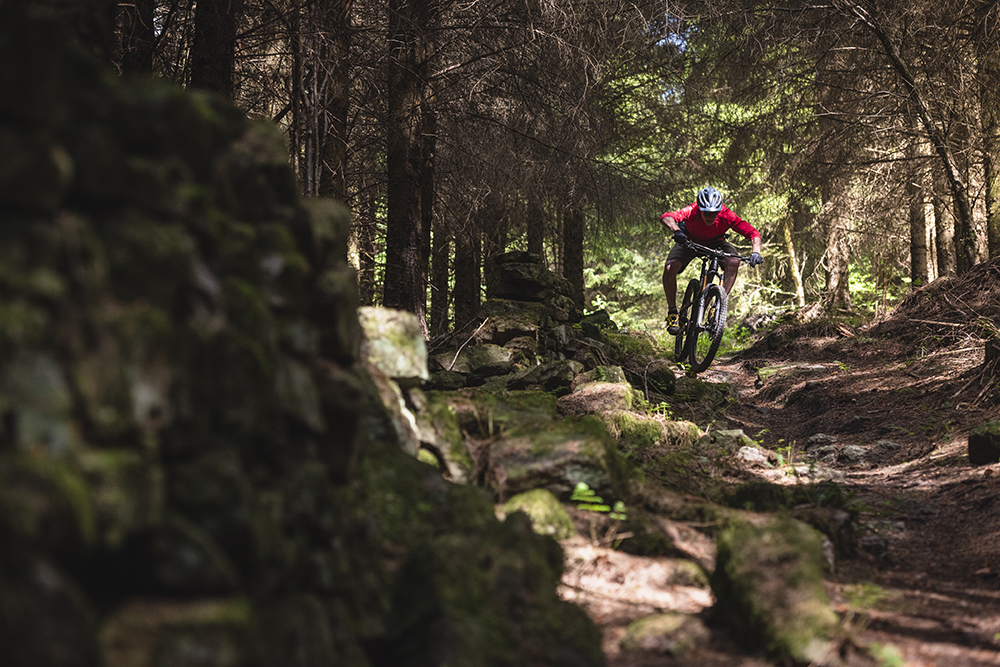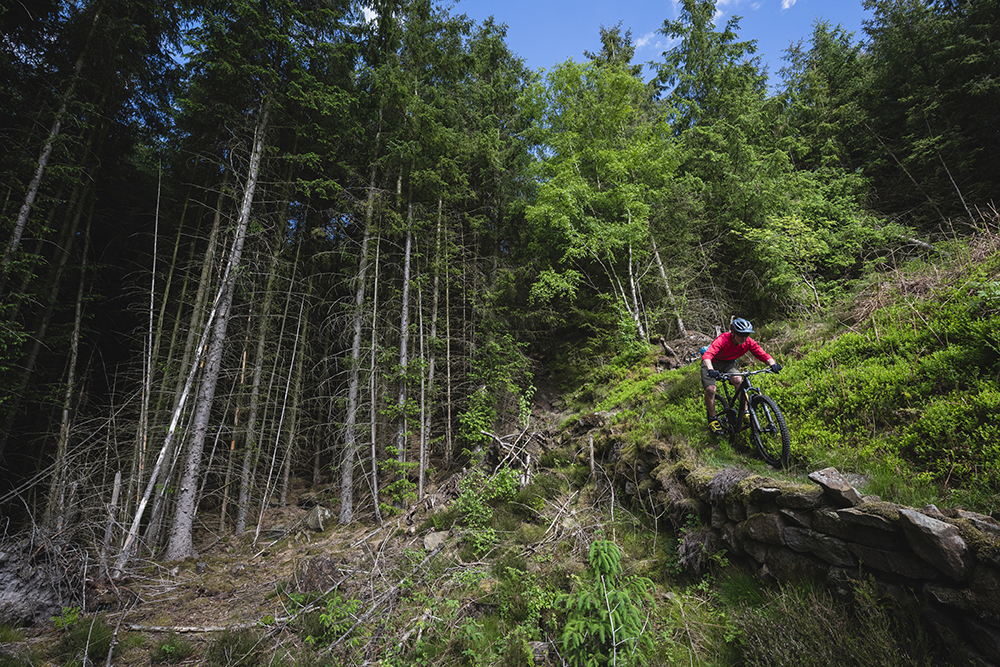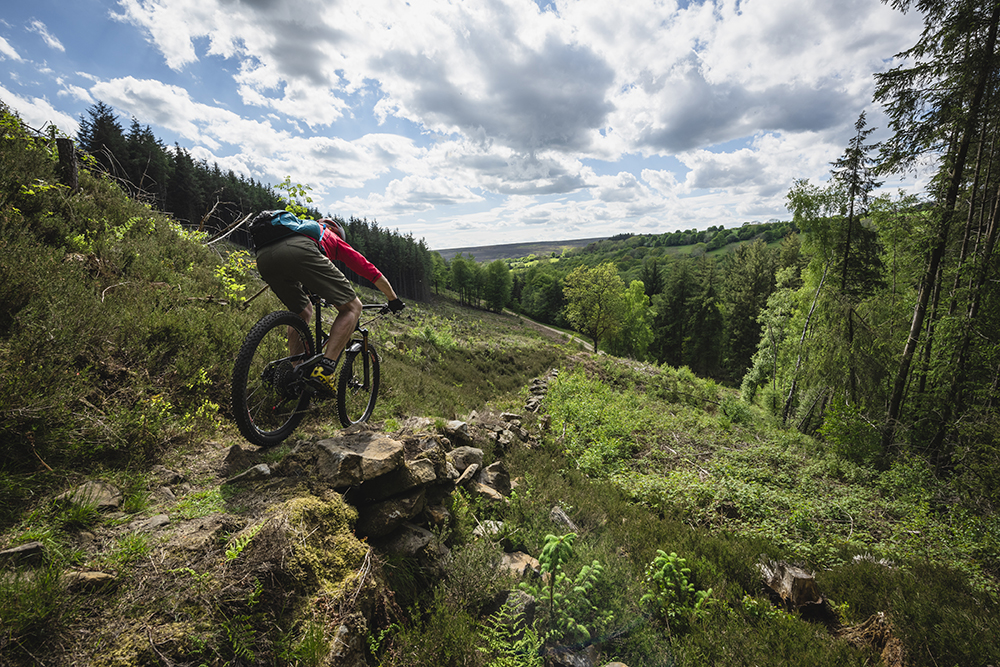Pace is not a one man band, Adrian Carter is joined by his wife and two daughters in creating the modern day company
Pace has played a role in history of British mountain bike design for over 30 years – we visit founder Adrian Carter at their North York Moors base.
Words & photos: Sim Mainey

There are few British mountain bike brands with a history as long and storied as Pace Cycles. For 32 years this family owned firm has been doing things their way, seemingly more interested in pragmatic innovation than trend chasing. In the process they’ve developed some era defining bikes and ideas that were way ahead of their time.
Back in 1987 Pace rolled out their first bike from a basement in Bradford. The RC100’s most eye catching feature was the machined square section aluminium it used instead of tubes, something that came to define Pace. But the RC100 was more than just a box section bike, details such as direct fit Magura hydraulic rim brakes, a threadless headset and an integrated stem steerer were unheard of. It was a revolutionary bike, one that borrowed ideas from the off-road motorcycle world at a time when most mountain bikes were little more than adapted road bikes. The bikes that followed such as the RC200 F8 and the full suspension RC500 look like bikes from the future even today.

While Pace might have been born in West Yorkshire its spiritual home, and actual home for the last 30 years, is the North York Moors.
Adrian Carter, Pace’s founder, managing director and designer, is quite open about the fact that he’s used Pace to live the life he’s wanted to live. Rather than be consumed by the quest for perpetual growth and chasing change for change’s sake he’s made sure that the business has worked for him, rather than he for it. This includes where he’s decided to base the company. While many bike brands operate out of industrial estates Pace HQ is a beautiful converted stone barn in the picturesque town of Thornton Le Dale.

At the digital draughtboard designing another potential award-winner
Adrian splits his work time between the office and home where he does most of his design work and which also happens to be closer to the trails.
Having trails on your doorstep usually means being close to good riding, but for Adrian the trails could only be closer if they started from his doormat. Ten metres from his front door is the start of singletrack that rapidly draws you deep into some of the lesser known gems of the North York Moors. These are the trails that Adrian has used to develop Pace’s latest bike, the Pace RC295.
The RC295 is a 135mm travel full suspension trail bike. The frame’s square section carbon fibre is a nod to Pace’s past but this is a thoroughly modern bike.

Box-section frames are Pace’s signature style
Motorbikes and mullets
The bike that Adrian is riding is a second generation frame (the third and final version is due any time now) with 29inch wheels, but it has the ability to run a 27.5inch Plus rear wheel to turn the RC295 into an on-trend mullet bike (big wheel at the front, smaller wheel at the back). The mullet development doesn’t come as a surprise to Adrian. A highly accomplished off-road motorcycle rider and racer it seems like a logical progression – as he points out mountain biking is still a young sport but off-road motorcycles that use a larger diameter front wheel and a smaller rear wheel, are highly evolved. A lot of the answers to problems that mountain bike designers have have already been answered by the likes of Honda, KTM and Kawasaki.
It’s not a great surprise then that Pace’s floating shock suspension design is based on a Suzuki design. It uses a lever at either end of the shock allowing for fine tuning of the way the suspension is managed. It’s a very design sensitive system, one that requires a lot of attention at the design stage but the reward is a long travel feel and the ability to squeeze the full potential out of today’s shock technology.

Adrian founded Pace to pursue his passion
The RC295 has been in development for “too long” says Adrian with a roll of the eyes. Too long proves to be five years with the bike going through at least 30 different iterations in CAD. Despite a lot of computer modelling actual real world testing is done by the seat of the pants, working out what constitutes ‘the best’ is done by feel rather than numbers.
The next model in Pace’s full suspension line up, a 165mm travel model, is already well advanced and should be finished a lot quicker. There is also a Pace e-bike in the works. With a love of bikes with and without engines it’s probably no surprise that Adrian is keen to create an e-bike, but it’s the fact that they break down barriers and allow non-riders into the sport that really excites him about the technology. More people on two wheels can only be a good thing.

Pace’s Yorkshire roots are part of its long-standing appeal
Apart from in some of the nooks and crannies of northern Scotland wilderness has faded from Britain. Our landscape is the product of man’s management of nature. That’s not to say you can’t get the feeling of isolation that wilderness gives though. Despite being a national park the NYMs are a quiet place to ride. The forests are large and for the most part empty, well known centres like Dalby Forest and Sutton Bank drawing most of the traffic.
When developing a new bike Adrian spends a lot of time riding on his own, letting his mind focus in on what the bike is doing. The RC295 is very much a product of time on these trails. With moorland singletrack, rough and ready forest trails, steep, technical and flowy man made trails and everything in between Adrian doesn’t need to go far to find all kinds of terrain for testing. That’s not to say he doesn’t leave Yorkshire though – the bike has been tested from the Lakes to the Alps and before final signing the bike off Adrian is taking it to Colorado and Utah. The RC295 is a bike designed to be ridden anywhere but its heart is firmly in North Yorkshire.

Motorhead Carter’s bike bears the Pace of Spades
A family affair
North Yorkshire is putting on quite a show today. The sun is out and wild garlic carpets the side of the wooded trails. There are no tell-tale tyre tracks in the dirt, no footprints, no sign of anyone in fact. We ride between two towering hedges, the trail axle deep in early summer growth, before turning into a hollow with a brown strip of earth that toboggans down the hill. Just a few inches wide in places it cuts through the wild garlic and around trees making seeing past the next corner difficult. Shaded by the thick leafy canopy the ground is still soft in places and off-camber sections have the sides of the tyres clawing for grip. It’s hard to believe this trail hasn’t been built with bikes in mind, it’s even harder to believe Adrian has all this to himself.
Despite having a blank canvas for trail creation Adrian is more a trail enhancer than a builder. With a mental map of all the trails in the area built up over the years Adrian is always looking for new ways to link things up. A fresh deer trail might, with a bit of a sweep, help join up two previously unconnected sections and create a new loop or a little bit of clearing might yield a way to access an unexplored part of hill but there’s no real desire to take a spade into the woods, there’s simply no need.

Design concepts get a Yorkshire reality check on the trails around Pace HQ
An inquisitive mind is vital for trail finding and for bike design. Adrian points out there are a lot of similarities, you’re looking for ways to join things up in your head, to look round corners and make things work mentally before committing to any action.
Despite not sculpting trails Adrian does sculpt frames, using fibreglass and polyfiller to create mock-ups so that he can better assess how an idea will look.
A carbon frame might raise a few eyebrows but Pace has a long history with carbon. As well as using lugged carbon tubes in their frames Pace manufactured forks, rigid and suspension, that used carbon extensively. Having developed a range of suspension forks that were known for their low weight, stiffness and stunning looks Adrian realised that he was fighting a losing battle. The fork aftermarket had contracted as the forks being supplied on bikes were improving and the bigger players were rapidly iterating their offerings. To keep in the game Pace would need OE contracts with bike manufacturers and to ramp up production. Adrian decided he wanted off the treadmill so sold the rights to the suspension fork design to DT Swiss and took Pace back to a level he was happy with.

A bike from a small brand is always going to be a reflection of the people behind it and their environment. As a designer Adrian has always tried to create the bike he wants to ride and as a self-proclaimed stubborn Yorkshireman he’s quite happy to plough his own furrow and do things his way. It’s this deeply personal connection to his creations that helps to make a Pace a Pace, but it also comes with a downside – negative comments hurt more when you put a bit of yourself into your creation.
Pace is not a one man band though, in fact Adrian is joined by his wife and two daughters in creating the modern day company. Each add their own character to the brand, moving things on and making Pace work for them.

Free-floating linkage squeezes the shock at both ends
Forever changes
We veer off the fireroad down the vaguest of lines. Calling it a trail would be overstating it, it’s a slight scratch through the scrub at best. Twisting into the trees the line becomes more defined and it switches this way and that making me very conscious of my wide bars.The trees get denser and things get darker. Deep in the forest there’s the beautiful aroma of baking loam. A sweet, warm smell of pine and dust. Much like Pace the forests here have changed and evolved to suit the times. A drystone wall runs pointlessly through the trees, keeping nothing in or out. Parts of the wall have been taken down and used to fill muddy sections of the trail – finding a new purpose while its original has long been forgotten.

For riders of a certain age, the Pace sticker on a frame signifies innovation and passion
One of the best changes to be found in forests is the introduction of a good café. It seems rude not to stop and have a brew before carrying on. Riding, says Adrian over a coffee, satisfies something deep inside and a bike should help to bring that out, to enhance it. With the RC295, as with all Pace frames over the years, Adrian’s tried to find a balance of characteristics that make for a bike that maximises fun and makes for a confidence inspiring ride. “We’ve done the longer, lower, slacker thing in the past. I’m not saying we’ve always done it but if you look at the RC500 DH bike from the late ‘90s, that was as long as motorcycle enduro bike.” With a 30 year history it’s no surprise that some ideas from Pace’s past have come back around. The key difference is designers like Adrian now have the components they need to make the bikes they want to build – companies like SRAM have produced simple solutions to awkward questions, 1x drivetrains, BOOST spacing, dropper seatposts have all made for better bikes and a better ride.

The company has no plans to ride off into the sunset
Time and evolution aren’t always kind though. The Rosedale Abbey singletrack was at one point some of the finest singletrack in the country and a trail MBR has raved about in the past. Now it’s a struggle to even find it. The trail has been lost under heather, a more obvious route created by quad bikes below the original trail is what most riders will pick up and ride. There are just flashes of the old trail here and there, dashes of white on the grey and brown moorland. Use it, maintain it or lose it seems to be the message here. If a trail as well loved as this can vanish it proves how fragile our trail network really is. Adrian and I ride the sections of the old trail we can but give up and loop onto the main track, a wide and fast descent back to the valley bottom.
Pace’s ability to evolve has been key to its longevity, adapting and changing to both the market but also to what the Carters want from it. With Adrian still very much driven to carry on designing and the next generation of the family keen to make their mark on the brand Pace, true to its name, isn’t standing still.




